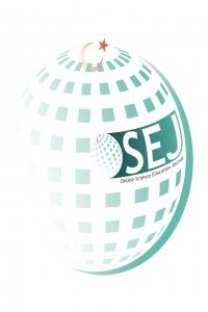Effects of 3D Applications in Organic Chemistry Lessons on Preservice Teachers’ Spatial Ability
Chemistry lessons, especially organic chemistry lessons, requires basic skills to imagine and mentally rotate 3D and 2D objects. These skills are related to spatial ability. For a meaningful learning students have enough spatial ability and teachers should consider to develop students’ spatial ability. Spatial ability could be developed permanently by activities and trainings. 3D printers and 3D pens could be effectively used to design and apply such activities. This research is conducted to analyze the effect of 3D applications on Elementary Science Education students’ spatial ability in Organic Chemistry lesson. Organic molecule models were designed and printed in 3D printer. The molecules were used in Organic Chemistry lesson to show coordination of atoms. Also students draw 3D molecule structures by using 3D pen. The Purdue Visualization of Rotation Test was administered as pre-test and post-test to analyze spatial ability level of students. Result of the study shows that; traditional Organic Chemistry lesson has no significant effect on spatial ability development, however, 3D applications have significant effect on spatial ability development
Anahtar Kelimeler:
Spatial ability, 3D pen, 3D printer, Organic Chesmistry
Effect Of 3D Applications In Organic Chemistry Lesson On Students’ Spatial Ability
Chemistry lessons, especially organic chemistry lessons, requires basic skills to imagine and mentally rotate 3D and 2D objects. These skills are related to spatial ability. For a meaningful learning students have enough spatial ability and teachers should consider to develop students’ spatial ability. Spatial ability could be developed permanently by activities and trainings. 3D printers and 3D pens could be effectively used to design and apply such activities. This research is conducted to analyze the effect of 3D applications on Elementary Science Education students’ spatial ability in Organic Chemistry lesson. Organic molecule models were designed and printed in 3D printer. The molecules were used in Organic Chemistry lesson to show coordination of atoms. Also students draw 3D molecule structures by using 3D pen. The Purdue Visualization of Rotation Test was administered as pre-test and post-test to analyze spatial ability level of students. Result of the study shows that; traditional Organic Chemistry lesson has no significant effect on spatial ability development, however, 3D applications have significant effect on spatial ability development
Keywords:
Spatial ability, 3D pen, 3D printer, Organic Chemistry,
___
- Akpolat, O. ve Kartal, F. (2009), “Kimyacılar için Bilişim Teknolojileri”, Akademik Bilişim’09 - XI. Akademik Bilişim Konferansı Bildirileri, 11-13 Şubat 2009 Harran Üniversitesi, Şanlıurfa.
- Barta N.S. ve Stille, J.R. (1994), “Grasping the Concepts of Stereochemistry”. Journal of Chemical Education, 71, 20-23.
- Carroll, J. B. (1993). Human cognitive abilities: A survey of factor-analytic studies. Cambridge University Press.
- Dalgarno, B. ve Lee, M. J. W. (2010), “What are the Learning Affordances of 3-D Virtual Environments?”, British Journal of Educational Technology, 41(1), 10-32.
- Hai-Jew, S. (2010), “Virtual Immersive and 3D Learning Spaces: Emerging Technologies and Trends.” USA: Igi Publishing.
- Kurbanoğlu, N ve Taşkesenligil, Y. (2002), “Organik Kimyada Stereokimya Konusunun Programlı Öğretimi”, V. Ulusal Fen Bilimleri ve Matematik Eğitimi Kongresi, 16-18 Eylül 2002, ODTÜ.
- Lohman, D. F. (1979). Spatial Ability: A Review and Reanalysis of the Correlational Literature (No. TR-8). School of Education, Stanford University
- Lu, Y., & Sireci, S. G. (2007). Validity issues in test speededness. Educational Measurement: Issues and Practice, 25(4), 29-37.
- Olkun, S. ve Toluk Uçar, Z. (2007). İlköğretimde etkinlik temelli matematik öğretimi. Ankara: Maya Akademi.
- Owens, K. D., & Clements, M. K. (1998). Representations in spatial problem solving in the classroom. The Journal of Mathematical Behavior, 17(2), 197-218.
- Pribyl, J. R., & Bodner, G. M. (1987). Spatial ability and its role in organic chemistry: A study of four organic courses. Journal of research in science teaching, 24(3), 229-240.
- Salkind, N. J. (1976). A cross-dimensional study of spatial visualization in young children. The Journal of genetic psychology, 129(2), 339-340.
- Solomons,T.W.G. (1990). Organic Chemistry. New York: Wiley.
- Yoon, S. Y. (2011). Psychometric properties of the revised purdue spatial visualization tests: visualization of rotations (The Revised PSVT: R). Purdue University.
- Terlecki, M. S., Newcombe, N. S., & Little, M. (2008). Durable and generalized effects of spatial experience on mental rotation: Gender differences in growth patterns. Applied cognitive psychology, 22(7), 996-1013.
- Yayın Aralığı: Yılda 2 Sayı
- Yayıncı: Mehmet ALTAN KURNAZ
